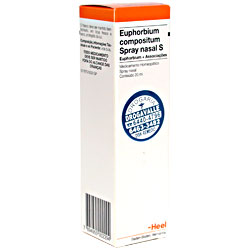Euphorbium compositum with (Homeopathic preparations Heel)
Euphorbium compositum C
Drops · Solution for injections
Euphorbium compositum-Nasentrophen S
Euphorbium compositum - Nazentropfen S
(Drops in nose) Sprayer with liquid without propellants

Composition : Drops : 100 ml contains: Euphorbium D3, Pulsatilla D2, Luffa operculata D6, Mercurius bijodatus D8, Mucosa nasalis D8, Hepar sulphuris D10, Argentum nitricum D10, Sinusitis-Nosode D13 1 ml. Contains alcohol of 45 volume%. Solution for injection: 100 ml contain: Euphorbium D3, Pulsatilla D2, Luffa operculata D6, Mercurius bijodatus D8, Mucosa nasalis D8, Hepar sulphuris D10, Argentum nitricum D10, Sinusitis-Nosode D13 1 ml. Nasal drops : 100 ml contains: Euphorbium D4, Pulsatilla D2, Luffa operculata D2, Mercurius bijodatus D8, Mucosa nasalis D8, Hepar sulphuris D10, Argentum nitricum D10, Sinusitis-Nosode D13 1 ml.
Indications: Drops : solution for injection: acute and chronic sinusitis, eustachitis, edema of the middle ear. Drops in the nose : rhinitis of various genesis (viral, bacterial, allergic), dry, hyperplastic and atrophic rhinitis, for auxiliary treatment of the lake. Chronic sinusitis. To facilitate nasal breathing during hay fever.
Dosage: Drops : usually 10 drops 3 times a day. In acute cases, begin with 10 drops every 15 minutes, reducing up to 10 drops 6 times a day. Solution for injection: in acute cases daily, in other cases 1-3 times a week for 1 ampoule subcutaneously, intramuscularly, intradermally, if necessary, intravenously. Drops in the nose : 1-2 injections into each nostril 3-5 times a day, children up to 6 years - 1 injection 3-4 times a day. Can be assigned similar to children up to 1 year.
Form of release and packing: Drops : the bottle-dropper contains 30 or 100 ml. Solution for injection : the package contains 5, 10, 50 or 100 ampoules of 2.2 ml. Drops in the nose : spray with 20 ml of the drug.
A brief description of indications for the use of individual components of the formulation: Euphorbium Inflammatory diseases of the respiratory tract (especially the higher: rhinitis and sinusitis). In addition: eustachitis and edema of the middle ear. Pulsatilla Inflammatory diseases of the respiratory tract, a tendency to catarrhal diseases. Conjunctivitis. Inflammation of the middle ear. Measles. Cefalgia. Neurotic disorders, disruption of the mood. Luffa operculata Coryza. Hay fungus. Mercurius bijodatus Purulent inflammation of the nasal mucosa, throat, tonsils and conjunctiva. Mucosa nasalis Chronic rhinitis, polysynusitis. Ozena. Polyps of the nose. Diseases of the paranasal sinuses. Purulosus purulent inflammation of the mucous membranes, chronic purulent inflammation of the middle ear, tonsillar abscess. Predisposition to diseases of the lymphatic system. Nervousness. Argentum nitricum Migraine. In addition: chronic diseases of the mucous membranes. Sinusitis-Nosode Recurrent sinusitis.
Based on the homeopathic components of the preparation, Euphorbium compositum S (droplets, solution for injections) is prescribed for acute and chronic inflammation of the paranasal sinuses (maxillary, frontal, latticed, wedge-shaped), with catarrhal inflammation of the ear tube and with dropsy of the middle Ear.
Nasal drops are indicated for chronic dry catarrhal rhinitis, dry mucous membranes of the nose in combination with chronic inflammations of the paranasal sinuses; To facilitate nasal breathing with a nervous and allergic rhinitis (hay fever), with acute rhinitis and catarrhal catarrh (contributes to secreting, facilitates nasal breathing, reduces pressure). They seem to be shown as if it were an adjuvant for a fetid cold (oasis).
The experimental use of this drug had a significant therapeutic effect, especially with chronic inflammation of the paranasal sinuses (dry appearance, atrophy of the nasal mucosa), as it reactivated the mucous membrane and caused its moistening (from the point of view of the regressive vicariation phenomenon). At the same time, it is recommended to prescribe the preparation Mucosa compositum, however, with long-term use of medications, including ointments, - preparations of Coenzyme compositum and Ubichinon compositum, promoting the activation of enzymes. In case of inflammatory manifestations, Echinacea compositum S, Traumeel S, Engystol N.
With aphonia, Euphorbium compositum S is assigned in combination with Echinacea compositum S, Mucosa compositum and Ubichinon compositum.
With edema of the middle ear and with chronic otitis, it is recommended to apply all three forms of Euphorbium compositum S.
Nasal drops have a specific counteraction to the functions of the mucous membranes of the nose and sinuses and in accordance with this are used to treat diseases of the mucous membrane of the paranasal sinuses, with acute and allergic rhinitis. The drug prevents the removal of swelling of the mucosa, does not cause reactive hyperemia with subsequent narrowing of the respiratory tract and contributes, thanks to the physiological saline solution, resorption of crusts and secretion products. It prevents the drying of the mucous membrane, ensures free breathing and relieves pressure in the forehead district. Long-term use of the drug does not reduce the therapeutic effect, but, on the contrary, increases it.


Comments
Commenting on, remember that the content and tone of your message can hurt the feelings of real people, show respect and tolerance to your interlocutors even if you do not share their opinion, your behavior in the conditions of freedom of expression and anonymity provided by the Internet, changes Not only virtual, but also the real world. All comments are hidden from the index, spam is controlled.